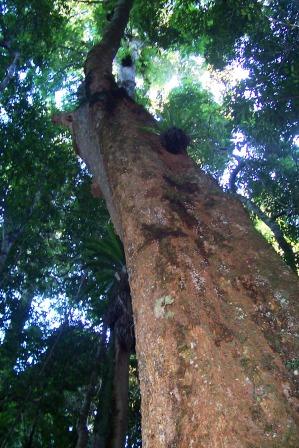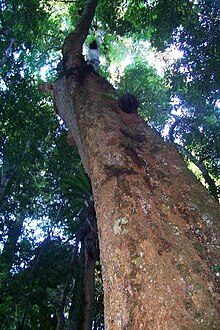User:Jumbocombo0811/sandbox
Info box dysoxylum franserianum
[edit]| Dysoxylum fraserianum | |
|---|---|
 | |
| Species | Meliaceae (mahogany family) |
| Location | Native to New South Wales and Queensland |
| Height | 40m (131ft) |
| Diameter | 3.5m (11ft) |
- Dysoxylum pachyphyllum is sometimes erroneously called D. fraserianum in older sources.
| Jumbocombo0811/sandbox | |
|---|---|

| |
| At Boorganna Nature Reserve, Australia | |
| Scientific classification | |
| Kingdom: | Plantae |
| Clade: | Tracheophytes |
| Clade: | Angiosperms |
| Clade: | Eudicots |
| Clade: | Rosids |
| Order: | Sapindales |
| Family: | Meliaceae |
| Genus: | Dysoxylum |
| Species: | D. fraserianum
|
| Binomial name | |
| Dysoxylum fraserianum (A.Juss.) Benth.[3]
| |
| Synonyms | |
|
List
| |
Answers to Module 7 Questions
[edit]Describe your media
[edit]A photography of the leaf of Dysoxylum fraserianum
Is it your own work (Links to an external site.)
[edit]It is not my own work, but this picture is creative commons licenses on google image
What is the file format (Links to an external site.)?
[edit]JPEG
What license (Links to an external site.) have you chosen?
[edit]CC BY
What category/gallery (Links to an external site.) will you add it to?
[edit]Australian Plant, Mahogany, leaf
How will you describe (Links to an external site.) the file?
[edit]{{en|A [[:en:australianplant|]]
Practicing Citation
[edit]This is a reliable source because of the coverage that the book received. The book acquires extensive media attention, for instance, ABC podcast interviewing the author, Morris Lake. The book is available in different libraries, including the University of Sydney Library and the National Library of Australia. This book can contribute to the ‘description’ and the ‘use’ section of my article, giving supporting details on describing the feature of the trees and explaining how this wood is applicable to our daily lives, especially as types of furniture. [4]
Business Queensland is an online website under the Queensland Government. Therefore, before releasing the article to the readers, the data undergoes fact checks to prevent inaccuracy and misinformation.this article will contribute factual information to the ‘description’ and ‘distribution and location requirements” sections. Under description, I will include the specific properties of rose mahogany (dysoylum fraserianum), such as its seasoning, durability, and density. These are the basic information that can give my Wikipedia article numerical data. Besides, the tree's geographical occurrence as mentioned in the source can contribute to the ‘distribution and location requirements’, which helps the reader better understand the suitable environment for the trees to grow in. [5]
This is another high-quality published book; the book is very academically written with a great number of details.The Forest Trees of Australia's target readers includes: botanists, students, environmentalists, foresters, and horticulturists. Nevertheless, this piece's content can be used in ‘History and Genre’ section that explains the classification of dysoylum fraserianum, its related species, and the common names. [6]
NSW Weedwise is a credible source because it is run by the Department of Industries under the NSW government.This journal can provide extensive details for the “description” section because the research identified that the weed of the Australian rosewood/ dysoylum fraserianum could threaten biodiversity. The claim is worth expanding and exploring on the Wikipedia page. [7]
This is a good and independent source because it is a piece of information released from the government website, the domain name .gov guaranteed the content as factual. The information that this article provides are important for my Wikipedia page because it helps explain the “regulation” section, emphasizing the current status of rosewood in Australia. Giving this section an Australian context is crucial since it is where the origin of dysoylum fraserianum. [8]
Citation
[edit]- ^ a b "Dysoxylum fraserianum". IUCN Red List of Threatened Species. 2020. 2020. Retrieved 03 May 2021.
{{cite journal}}: Check date values in:|access-date=(help) - ^ "Dysoxylum franserium (Common Ash)". IUCN Red List of Threatened Species.
- ^ Cite error: The named reference
NSW PlantNetwas invoked but never defined (see the help page). - ^ PUBLISHING, CSIRO. Australian Rainforest Woods.
- ^ Fisheries, Agriculture and (12 December 2018). "Rose mahogany". www.business.qld.gov.au. Retrieved 3 April 2021.
- ^ PUBLISHING, CSIRO. Forest Trees of Australia.
- ^ "NSW WeedWise". weeds.dpi.nsw.gov.au. Retrieved 3 April 2021.
- ^ "Department of Agriculture, Water and the Environment". Department of Agriculture, Water and the Environment. Retrieved 3 April 2021.
Practice Lead
[edit]Dysoxylum fraserianum, also known as rosewood or Australian rose is one of the largest and most common trees belongs to the Melicaeae family. It can be found in New South Wales and Queensland Australia, spreading along the eastern coast. A fully grown dysoxulum franserianum can grow to around 40m (131ft) in height, with a trunk up to 3.5 metres (11 ft) in diameter.[1] The fruits are globular and pear-shaped, the size can vary from 1.5-4cm in diameter. The species is widespread in subtropical rainforest of Australia, a typical site for it is a flat or moderate slope close to mountain ranges.[2] It is a typical long-lived, slow-growing and shade-tolerant climax species. It has been extensively logged for its fragrant red timber, developing into other products like rosewood oil and furnitures. They are then export internationally to countries like China, triggering price booms in the market during the recent years.[3]
- ^ PUBLISHING, CSIRO. Forest Trees of Australia.
- ^ "ParlInfo - Australian rainforests in New South Wales / by Alexander G. Floyd". parlinfo.aph.gov.au. Retrieved 28 March 2021.
- ^ Zhu, Annah Lake. "Restricting trade in endangered species can backfire, triggering market booms". The Conversation. Retrieved 28 March 2021.


